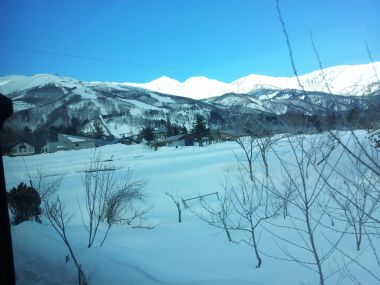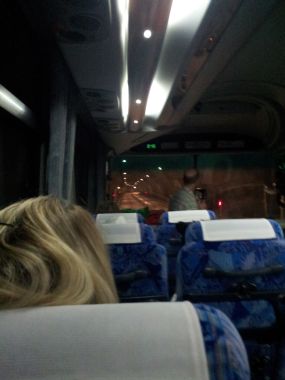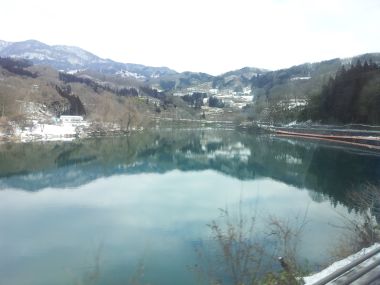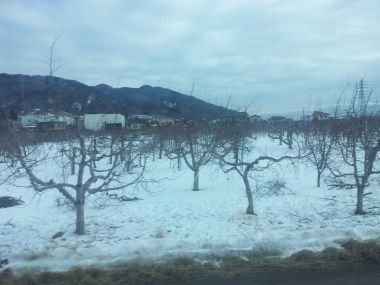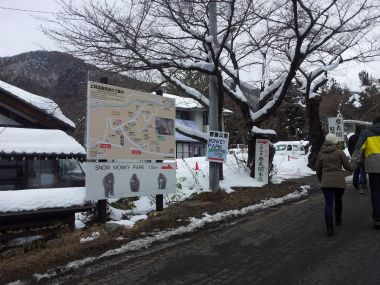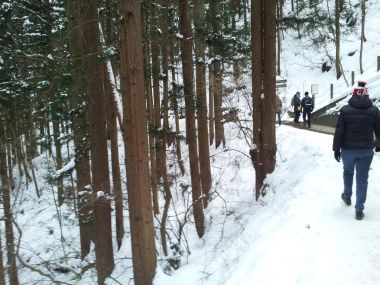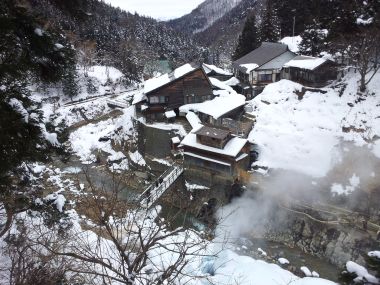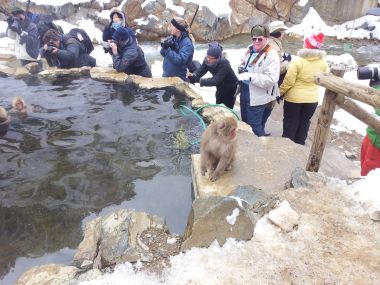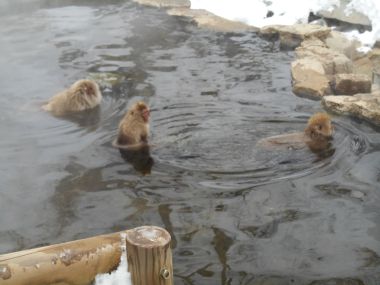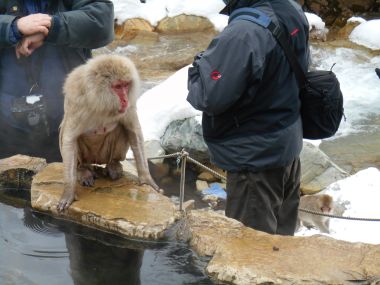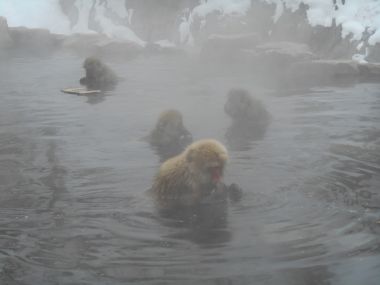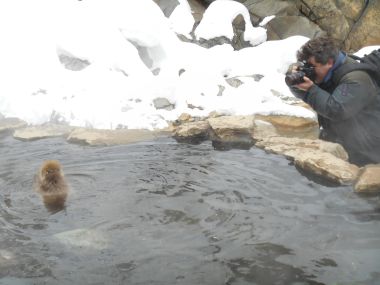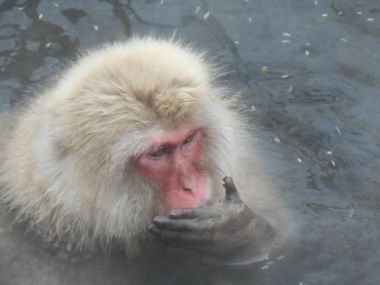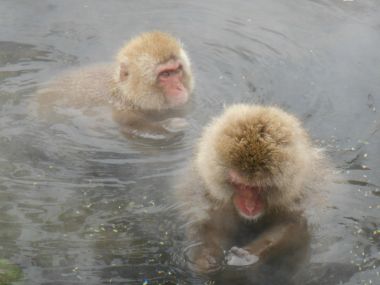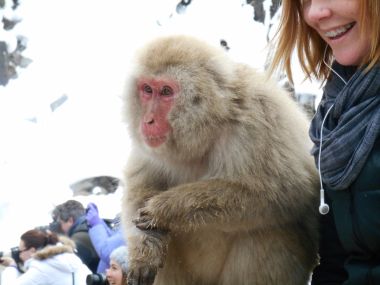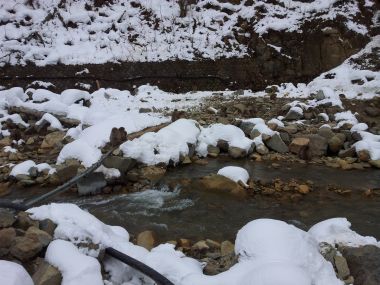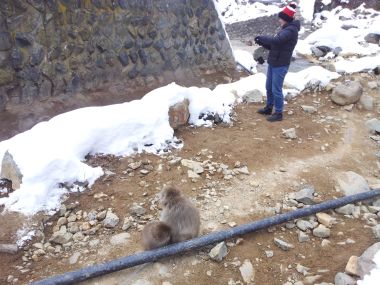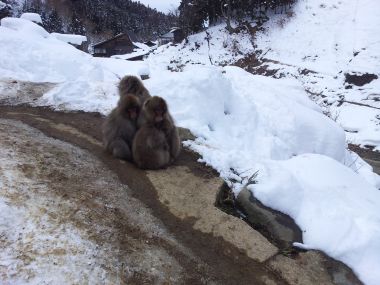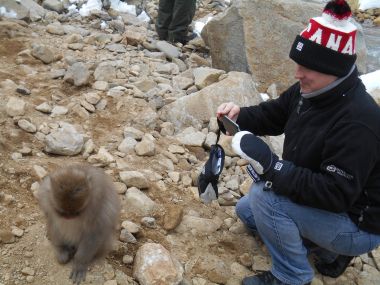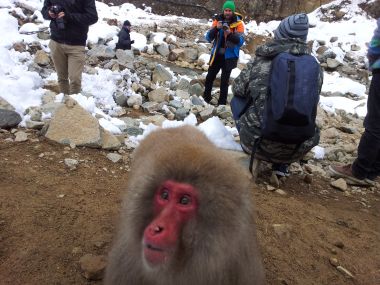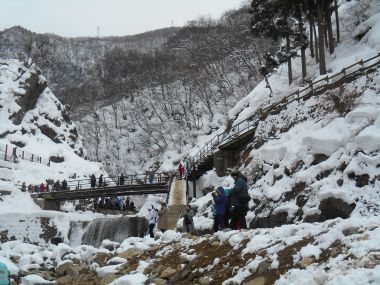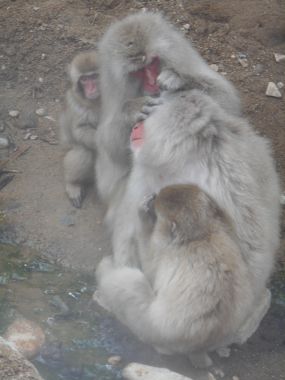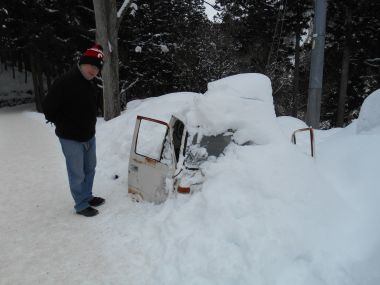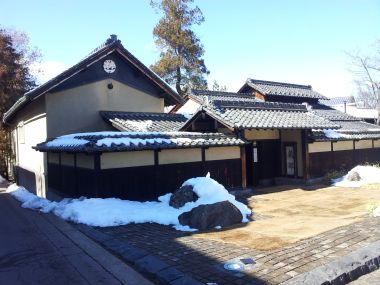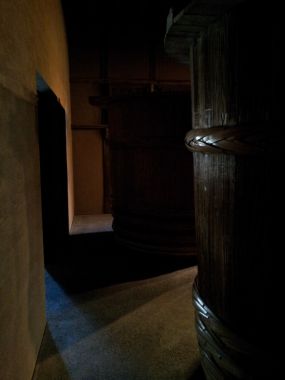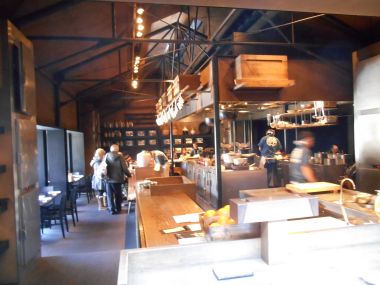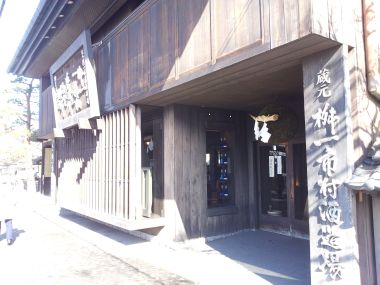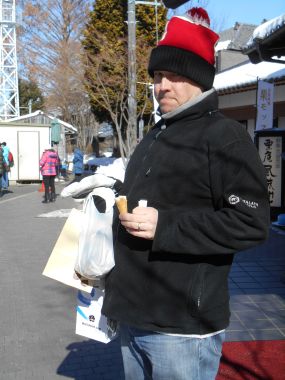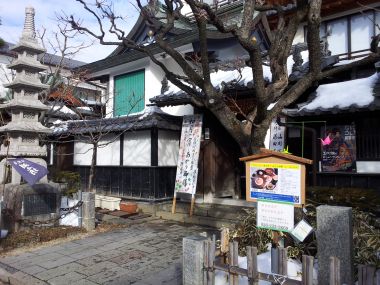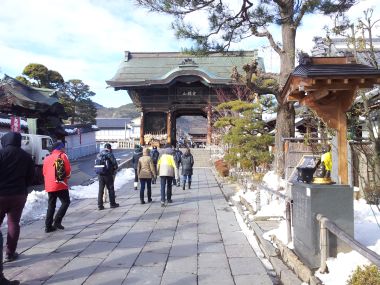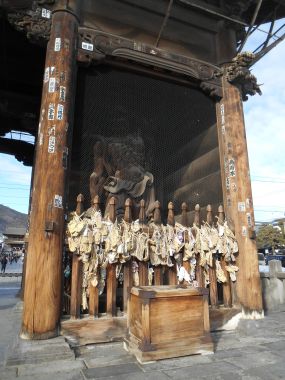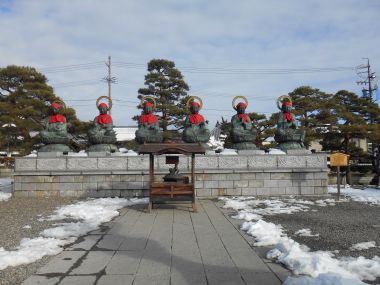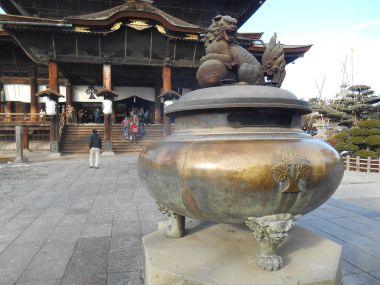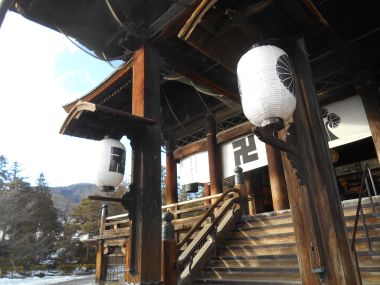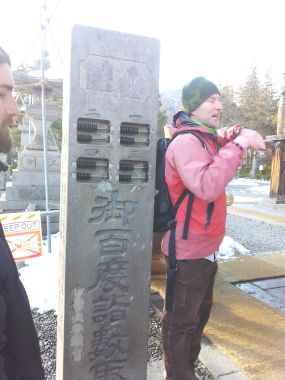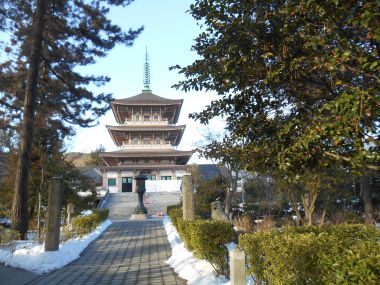Wednesday, February 12th, 2014
Monkey day! And, thankfully, a bit of a break from the skiing. We have never done this on a ski trip before but with a six day ski pass we both agreed it was a good idea to take a break and what better way than to see the famous Jigokudani Snow Monkeys.
We decided to give the Japanese breakfast a try again today with the much earlier start time for us (7:00 am). It does tend to be on the fishy side which is taking a bit of getting used to. Today was no exception with a small light rectangular piece of white fish as the main (including two preserved cherries which I thought quite odd) with a light green bean salad, a light white radish salad and a small deep-fried (mild) cheese croquette with plum sauce. All simple flavours presented extremely nicely and tasting quite nice.
The hotel owner had promised to take us to where we to join the tour and he was true to his word taking us up to a rental shop in Wadano a few minutes away from the hotel at 7:30. The tour was scheduled to depart at 7:45 so after checking in we wandered around the shop and looked at the ski items for sale. 7:45 we boarded the bus that pulled up outside. We had several stops to pick up others before we left Hakuba then we were on our way back to Nagano as the monkeys are in a park on the opposite side of the city.
Along the way the guide was very interesting telling us about the area and what we were seeing. He explained about the local farmers that own the land the ski areas are on and how they are quite protective leading to the difficulty in moving from one area to the other. All of the infrastructure in the resorts (the new road, the lifts, etc) was put in place for the Nagano Olympics in the hope that it would lead to more people coming to the area but this never happened so they have not upgraded any of the lifts (for example) since then (which explains why they are not very good…). As we passed by a school in one of the villages he explained that there are only a small number of children attending an enormous school and they are actually closing schools due to the low birth rate in the country but also that many young people are leaving the small villages and moving into the big cities. It is often difficult for farmers to sell their lands as often they have burial plots on them so re-development or consolidation of land is very difficult.
In Nagano we stopped at a large shop with a big car park where I guess they mostly receive large coaches such as ours. Inside they were selling a number of local speciality foods but for us this was a quick 10 minute toilet break (the toilets were very nice thank-you). It looks like a lot of our group have not eaten as they were queuing up for some hot food to takeaway.
As we continued through Nagano our guide pointed out the apple trees that are everywhere and is a speciality of the area. He suggested the reason why there is this culture of speciality items is because for the most part the Japanese do not buy these things except once or twice a year to give as gifts so in doing so they want to make sure they only give the best and are willing to pay more for it. This idea explains a lot of the customer service and amazing local specialities we see everywhere gorgeously packaged and presented. It also, of course, has to do with pride - It is with a great deal of pride that the people growing or making the items have so they want to make sure it is perfect. He told the story of how he once went picking apples for a local farmer and at one point dropped an apple on the ground - Immediately that was put into the “apple sauce” box and he felt ashamed - The farmer took quite good care of the apples including turning them on their branches so that they were evenly coloured by the sun. Any mis-shaped or otherwise imperfect apples are discarded but the perfect ones demand a high cost. People will pay it.
We also found interesting the guide talking about the legacy of the Nagano Olympics as he pointed out the various buildings for the different venues (they were quite noticeable in that they stand out from what is around them - quite large, modern and unusual looking buildings in the midst of normal houses and shops). For the most part they have been re-purposed but they are all still there. We were told that the area has many ski areas that are not doing all that well after the recession since many people do not have a lot of money to spend on expensive hobbies like skiing.
We were also told a bit about the Snow Monkeys. The story is that there is an old Japanese Inn on the site that was well known for it’s outdoor hot springs. A few years ago a troupe of monkeys (these are simply “Japanese macaque” monkeys) moved into the area and noticed the humans in the water and decided to see what the fuss was about. They shortly realized that the hot water was quite nice and wanted to spend more and more time in there. The customers at the Inn were not that pleased having monkeys in the hot springs (and the associated…waste) so the Inn built a hot spring area specifically for the monkeys a short distance away from the hotel. This caused a lot of attention so they made it into an attraction. It is run as non-profit and the wardens do not interfere with the monkeys in any way (they are just there to make sure the HUMANS behave themselves) - They tried once to take away a sick monkey for treatment but were quickly surrounded by the rest of the troupe so they now simply “let nature take it’s course” (monkeys about to die simply walk away from the troupe and never return).
The coach trip took about an hour before we arrived at the Snow Monkey park. Because of the nature of the park it was a long walk to where the monkeys actually were.
First we had to walk up a road for about 10 minutes then along a path through the woods and along the mountain for another 35 minutes before we arrived at the gate to the park itself. The path itself was quite enjoyable with pictures and information along the way and some gorgeous scenery - Tall pines all around us.
We passed a few people along the way but it was not really busy. Just before the entrance we came upon the 100-year old inn built on the far side of a stream. It is small but quite an amazing wooden building at the bottom of a ravine with the river running around it - An interesting assortment of structures that just seem to be attached to each other at odd angles - Grown rather than built.
A small footbridge takes people from our side of the stream into the hotel and there is a geyser nearby. We had to climb up some steps to get to the entrance where our guide was waiting with our tickets (I had to take a quick stop in the toilets which were, as the guide had warned us, not very nice but thankfully I did not have to sit down).
The monkeys are everywhere and seem untroubled by the attention of the crowds of tourists taking their pictures. Often their visitors would get within a foot to take their picture without any problems though a couple of times people got too close and the monkeys made their displeasure known (screeching and baring their teeth). There are rules posted everywhere about “do’s and don’t” and the guide had also let us know - You are not allowed to touch or scare the monkeys(!), you are not allowed to feed the monkeys (only the rangers can do this), no eating (of food yourself) allowed (as the monkeys will grab it from you) and no pets (!). While all of the people milled about the monkeys, for the most part, went about their business which seemed to be either sleeping together in clumps, grooming each other, or eating. Indeed there was a small excavator moving some rocks around by the stream that the monkeys completely ignored despite the loud noises and violent movement of earth. The rangers were sprinkling food around (that we were told supplements their diet in the winter months) including in the “monkey pool” which is a circular shape that you can look into from above or walk around the outside nearest to the stream. Of course, sprinkling the food into the pool meant there were monkeys in there eating untroubled by the heat of the steaming water.
Near the pool one of the wardens was feeding a monkey sitting on the railing and encouraging people to sit beside it for pictures (remember, no touching!).
The area we were allowed to visit was basically the far end with the pool then a lower flat section before a small waterfall that marks the end of the park (before the Inn below). The flat section was where the majority of the monkeys were and most of them were sleeping or grooming each other.
We were surprised at the number of young monkeys but I guess because the conditions are so good for them (heat all year around and food supplements from the rangers) this is ideal breeding grounds.
At one point, yes, I did get a warning from a monkey, but, no problems I backed away - I had been crouching on the ground trying to get a close up…
What I found interesting to note was that there were very few children visiting the park possibly because of the long walk, the nature of the monkeys (wild and would not respond well to a child attempting to grab them) or the fact that it was the middle of the week and it was not a holiday…
Some pictures from Flickr…
We spent as much time as we could there then realized we had to hurry back to the coach as we only had 30 minutes before we were scheduled to leave and it was something like a 45 minute walk!
Mind you, did not really have to hurry as when we did get back to the bus we were one of the first ones there. On the way we did notice what we had missed before - There were monkeys around the Japanese Inn as well - Walking around as if they own the place! Probably would be an interesting place to stay…
We made our way back towards Nagano where we stopped for our lunch break at a small town called “Obuse” which is known, traditionally, for it’s 240 year old sake brewery “Masuichi”. The brewery has a small and, evidently, quite exclusive restaurant where we were to have lunch.
Half of the restaurant was set aside for us and as we sat down our appetizer and a small glass of their sake was waiting for us (of course both mother and I passed on the sake - literally - we passed it to the family sitting beside us - I did smell it and it seemed incredibly strong). Mother and I sat at a table overlooking the cooking area which provided no end of visual entertainment for the meal. The appetizer was a small bowl with a large dried mushroom (rehydrated), a piece of what I can only assume was a tofu, and a oblong shaped piece of white turnip. Interesting but hardly earth-shattering so, on to the main course…I chose the “beef” which was a small plate of marinated (local) beef with a bit of lettuce and a side of miso soup and rice (of course). The miso soup was quite nice as it had a lot of mushrooms in it…Mother had the “fish” which was some local smoked fish with seaweed (and miso and rice). Desert was a simple small plate with two slices of one of the local specialities - Apples - with only a sliver of their skins remaining. Very nice.
The restaurant itself is in a corner of the brewery. When you visit the (very nice) toilets there are two massive vats in a room that were previously used for brewing. This room also has a few other brewery artefacts in cases.
The interior of the restaurant itself is quite dark with all of wooden walls quite black and with only spotlights in the ceiling lighting up the place. I guess it is quite “chic”.
Leaving the brewery I was determined to get a small bottle of sake for Mel (just because I don’t drink does not mean my wife does not drink!) because I know she is not much of a drinker and she might just like it - In the restaurant they had a write up at every table about the five different sakes they brew here so I already had an eye on one that I thought she might like: “Hekiiken” which is described as “An easy-to-drink top-quality daiginjo sake. A relatively new sake make with the sensibilities of wine in mind and has a vibrant, slightly fruity flavour.” Sounded ok. Anyway, we found the shop around the front of the brewery but could not find anything smaller than 500 ml…when we asked the shop assistant he seemed to understand we wanted something smaller…and brought out the 500 ml. (sigh) Anyway, it is a beautiful bottle and I hope she likes it.
We visited several of the small shops alongside the brewery including an interesting paper shop that had very nice paper (including hand made) as well as paper-based items (such as origami figures). Spent some time just being amazed at what they had.
One of the local Obuse specialties is chestnuts and there is a whole shop devoted to biscuits made with them. They are quite small rectangular biscuits that are quite nice if not really all the sweet. Luckily they had samples…but I picked up a small box for Mel as well.
Down the street there was a lady we had been told that “would talk our ear off” who, evidently lived in Switzerland for a time with her husband so made very good, what she called, “strudel” that we had to give a try (one one that we split). She also spoke very good English. Anyway, it was a very nice pastry dessert but not quite what I would call strudel. Yes, she did have a bit of a chat with us as well. Next door we followed that up with some chestnut ice cream (after mother had a quick sample to make sure it was edible). It was very nice. They had a bunch of other flavours including wasabi (!) but we gave those a miss. The final purchase was of a rather large bag of freshly roasted chestnuts (500 yen) from across the road which were very nice indeed (I ended up eating them for the rest of the day).
Our final site to visit was the Zenko-ji (Buddhist) temple in Nagano itself. The coach pulled over to the side of a busy road to let us out and we walked the few blocks up to the main temple gates. It was freezing - Cold with snow on the ground and quite windy. All along the road and into the temple grounds on both sides there are still inns and restaurants operating from when pilgrims used to make their long journeys to visit.
It is much less busy than Senso-Ji in Tokyo and even those temples we visited in Kyoto.
At Zenko-ji there is a statue that is said to be the first statue depicting Buddha in Japan. The rules of the temple state that it cannot be seen by anyone (including the priests) so a replica was made that can be viewed once every six years. There is also a key that hangs on the wall of a pitch black tunnel that runs under the temple that it is said that whoever touches it will obtain a degree of enlightenment…Mother does not like tunnels so when our group split into two: One for the tunnels (guided by a priest) and one for everything else (guided by our guide) we stuck with the “everything else”. He started by explaining about all of the shoes and sandals (mostly made of hemp) tied on the main gate being a gift from the pilgrims who travelled long to get here.
Next our guide explained the water and incense at the entrance of the main building are for cleansing before you enter. Inside the main building we were told not to take pictures and there is a large sitting statue of Binzuru, a physician follower of Buddha, near the entrance that is well worn in spots - Evidently if you rub a spot on the statue that is causing you problems on your own body then you will be cured. He also explained a bit about the various statues that we have noticed in other temples including the six “Bodhisattvas” who gave up Buddhist enlightenment in order to provide salvation to others. He explained that the red (cloth) bibs they are adorned with are not only good luck but also as an offering to the Bodhisattvas so that they will help children who have died prematurely achieve enlightenment (ok, I have shortened the actual story but you get the drift, I am sure).
Here at the temple, I later learned, they have a light show at night that lights up the various buildings in different colours this time of year. A small group of young people from our tour split off to find something to eat, see the light show and make their own way back to Hakuba (evidently they lived in Japan so getting around was not a problem for them).
I asked about what looked like a series of four abacus (abacusi?) on a pillar in front of the temple which had something to do with young priests racing back and forth between the buildings as part of their training - The abacus kept track of the number of times they did it.
It was cold and we had to stand around waiting for the tunnel group to rejoin us before we headed out of the side entrance to a car park where the (warm) coach was waiting. Our guide stopped talking, unfortunately, on the way back up the road to Hakuba. We had found him very interesting the whole day but I am sure many probably felt the never-ending talking perhaps a bit grating. We thanked him as we were dropped off at the Tourist Information building at about 5:30 pm.
Finishing off this wonderful day we had a phone call at 7 pm to call us down to our dinner. It was “Japanese casual” again (works for us so far…). Starter was several small pieces of pickled radish in a bowl with a light marinade. The second course was salmon and tuna sashimi served with some brightly coloured slices of vegetables. Next up was a whole steamed fish (!) that was so tender it fell off the bones. Our main course was a small container of meat (thin slices of the wonderful local pork) cooked over a small tea light (candle) then dipped into sauces. Delicious. Mother did not have the meat, of course, hers was some slices of fish. Our dessert had to be the best dessert we have had all week - A wonderfully tart creme brulee in a small raindrop shaped container. Amazing.
It has been a long eventful day and it will take a long time to absorb it all. It certainly will not be a day that either of us will ever forget. It is a privilege to be able to see these animals in their natural habitat. We also learned so much about Japan, the area and the monkeys as well with our really good guide. It was a very good break from skiing.
>> Next: Day 16
For further information, please see:
- Jigokudani Yaen-Koen - Official site for the monkey park
- Zenko-Ji Temple - Official site
- Nagano Travel: Zenkoji Temple - From japan-guide.com

